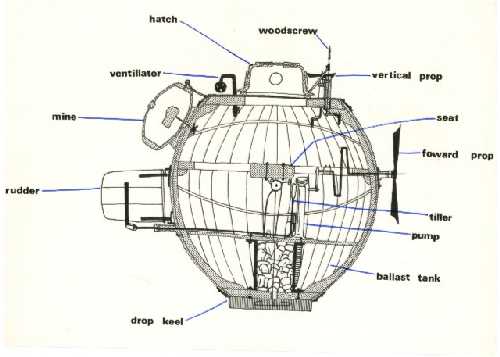| A
Full And Complete Accounting Of The Sonar System Aboard The TURTLE by Doctor Roger (Ramjet aka "Rammer") Burleigh, the Internationally renowned raconteur, roustabout submariner, learned diesel boat ping-jockey and connoisseur of the finer things in life. Note: Doctorate degree is strictly honorary. It was granted by the Grand Kahoona University (and mail-order sheep dip supply company) accessible only via an off-shore internet site.
Image source: http://www.ctrivermuseum.org/turtle.htm There is something missing from this otherwise detailed drawing. (Undoubtedly due to the confidential and sensitive nature of the information.) Unknown to most, the TURTLE had a small, but functional sonar room in the E&E space behind the seat. I wish I had my scanner connected so I could provide the drawings, (which were recently declassified by the present liberal government***, probably putting the entire submarine fleet in jeopardy). *** Treatise penned by Doctor Rammer in the latter days of the reign of Clinton. But, I don't, so this description will have to suffice. The designation of this "state of the art" equipment (please remember the circa we are dealing with) was "AN-PNG-1". It consited of a sealed funnel which passed under the seat shown and terminated forward in a thru-hull fitting which faced the front sealed end through the bow of the craft. The rear of this device swung upwards in a short 90 degree arc and it terminated in a diminative drum affixed to the small end of the "funnel". The "Sonar Technician" was wedged tightly (often an exciting and titilating experiance) in behind the helmsman, engineer, oiler, navigator, torpedoman. (This was the beginning of the odd relationship that exists to this day, between sonarmen and those big, greasy, hairy, nasty, enginemens.) AAaaannnnnyyyway.... . . . .. The sonarman, (when not otherwise distracted by the proximity to his crew-mate) would strike the drum end with a small hammer (which he kept hanging from it's lanyard, on a small brass hook screwed into the wooden hull of this unique boat.) This was a concern to the other crew member who was often hit by it, due to the swing caused by heavy seas when close to the surface. This, I believe started the saying "How is your hammer hanging?" Indicating a desire to have the lanyard shortened, and thus the arc of swing reduced. So, to continue, the sonarman, after striking the drum would immediatly press his ear to it's surface and listen intently. The operation of this primative system was simple. The vibrations of the hammer strike were amplified by the ever expanding diameter of the funnel shaped transmitter until they struck the diaphram on the exterior end. The sound waves were thusly transfered into the water to travel outward towards any solid body ahead of the submarine. I believe everyone is cognizant of the principals involved in the returning echo, caused by the initial sound wave striking the aforementioned solid body. So, when this returning wave encounted the receiving diaphram, it set up a sympathetic vibration that was carried and condensed by the now decreasing size of the funnel until it viabrated in turn the drum's surface alerting the sonarman to the presents of some foreign object in their path. With practice and training (offered by the famous Fleet Sonar School in Key West) the sonarman could determine what sort of object had returned the echo. He would then shout out, "Avast, ye miserable b*st*rd, get yer hand off'n me parts!!" No-no, that was from before. In this instance he would calmly announce, "Conn (et al), Sonar, I have a possible wooden, enemy vessel, bearing ahead, range less than 10 yards. (This was a safe estimate, as 10 yards was the maximum range achieved against a submerged, empty, steel, barrel. (This latter is still considered confidential by the submarine community, so apply the "loose lips ruling" to your now expanded knowledge.) His notification of target was often followed by, "Recommend all back emergency!" A hardly needed admonishment. This vital information would be processed by both crew members and used to position the turtle below the hull of enemy shipping. We all know that the helmsman, navigator, engineer, oiler would then become the torpedoman and screw his charge to the unsuspecting target, release the "mine" (this was often the job of the sonarman, due to his proximity to the release screw) and then reassume the position first suggested by his crew-mate,,, No-no, I mean the position of helmsman & engineer, whose job it was to flood negative and then make maximum going home turns on the forward "prop" screw. Hopefully providing a safe distance between the boat and the impending explosion. There, that, to the best of MY knowledge is a full and complete accounting of the sonar system aboard the TURTLE. "Nuff said! Rammer (Now I gotta go feed the goats!!) |
